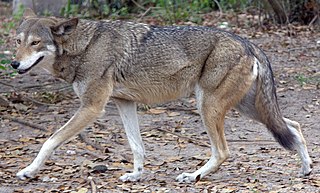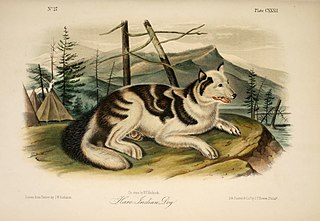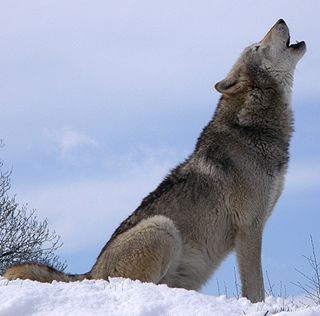
The coyote is a species of canine native to North America. It is smaller than its close relative, the wolf, and slightly smaller than the closely related eastern wolf and red wolf. It fills much of the same ecological niche as the golden jackal does in Eurasia. The coyote is larger and more predatory and was once referred to as the American jackal by a behavioral ecologist. Other historical names for the species include the prairie wolf and the brush wolf.

Canidae is a biological family of dog-like carnivorans, colloquially referred to as dogs, and constitutes a clade. A member of this family is also called a canid. The family includes three subfamilies: the Caninae, the extinct Borophaginae and Hesperocyoninae. The Caninae are known as canines, and include domestic dogs, wolves, coyotes, foxes, jackals and other species.

The red wolf is a canine native to the southeastern United States. Its size is intermediate between the coyote and gray wolf.

The wolf, also known as the gray wolf or grey wolf, is a large canine native to Eurasia and North America. More than thirty subspecies of Canis lupus have been recognized, including the dog and dingo, though gray wolves, as popularly understood, only comprise naturally-occurring wild subspecies. The wolf is the largest extant member of the family Canidae, and is further distinguished from other Canis species by its less pointed ears and muzzle, as well as a shorter torso and a longer tail. The wolf is nonetheless related closely enough to smaller Canis species, such as the coyote and the golden jackal, to produce fertile hybrids with them. The wolf's fur is usually mottled white, brown, gray, and black, although subspecies in the arctic region may be nearly all white.

The Saarloos Wolfdog is a wolf-dog breed originating from the Netherlands by the crossing of a German Shepherd with a Siberian grey wolf in 1935. The offspring were then further crossed with German Shepherds.

A wolfdog is a canine produced by the mating of a domestic dog with a gray wolf, eastern wolf, red wolf, or Ethiopian wolf to produce a hybrid.
A crossbreed is an organism with purebred parents of two different breeds, varieties, or populations. Crossbreeding, sometimes called "designer crossbreeding", is the process of breeding such an organism. While crossbreeding is used to maintain health and viability of organisms, irresponsible crossbreeding can also produce organisms of inferior quality or dilute a purebred gene pool to the point of extinction of a given breed of organism.

The Ethiopian wolf, also called the red jackal, the Simien jackal or Simien fox, is a canine native to the Ethiopian Highlands. In southeastern Ethiopia it is also known as the horse jackal. It is similar to the coyote in size and build, and is distinguished by its long and narrow skull, and its red and white fur. Unlike most large canids, which are widespread, generalist feeders, the Ethiopian wolf is a highly specialised feeder of Afroalpine rodents with very specific habitat requirements. It is one of the world's rarest canids, and Africa's most endangered carnivore.

A coywolf is a canid hybrid descended from coyotes, eastern wolves, gray wolves, and dogs. All of these species are members of the genus Canis with 78 chromosomes and therefore can interbreed. One genetic study indicates that these two species genetically diverged relatively recently. Genomic studies indicate that nearly all North American gray wolf populations possess some degree of admixture with coyotes following a geographic cline, with the lowest levels occurring in Alaska, and the highest in Ontario and Quebec, as well as Atlantic Canada. Another term for these hybrids is sometimes wolfote.

A bark is a sound most often produced by dogs. Other animals that make this noise include, but are not limited to, wolves, coyotes, foxes, seals, and barking owls. "Bark" is also a verb that describes the sound of many canids.

The domestication of vertebrates is the mutual relationship between vertebrate animals including birds and mammals, and the humans who have influence on their care and reproduction.
Canid hybrids are the result of interbreeding between the species of the subfamily Caninae.

The domestication of the dog was the process which created the domestic dog. This included the dog's genetic divergence from the wolf, its domestication, and the emergence of the first dogs. Genetic studies suggest that all ancient and modern dogs share a common ancestry and descended from an ancient, now-extinct wolf population – or closely related wolf populations – which was distinct from the modern wolf lineage. The dog's similarity to the grey wolf is the result of substantial dog-into-wolf gene flow, with the modern grey wolf being the dog's nearest living relative. An extinct Late Pleistocene wolf may have been the ancestor of the dog.
Canine reproduction is the process of sexual reproduction in domestic dogs, wolves, coyotes and other canine species.

The Hare Indian dog is an extinct domesticated canine; possibly a breed of domestic dog, coydog, or domesticated coyote; formerly found and originally bred in northern Canada by the Hare Indians for coursing. It had the speed and some characteristics of the coyote, and the domesticated temperament and other characteristics of a domestic dog. It gradually lost its usefulness as aboriginal hunting methods declined, and became extinct or lost its separate identity through interbreeding with dogs in the 19th century, though some claim the breed still exists in modified form.

The eastern coyote is a wild North American canine hybrid with both coyote and wolf parentage. The hybridization likely first occurred in the Great Lakes region, as western coyotes moved east. It was first noticed during the early 1930s to the late 1940s, and likely originated in the aftermath of the extirpation of the gray wolf and eastern wolf in southeastern Ontario, Labrador and Quebec, thus allowing coyotes to colonize the former wolf ranges, and mix with the remnant wolf populations. This hybrid is smaller than the eastern wolf and holds smaller territories, but is larger and holds more extensive home ranges than the typical western coyote.

A jackal–dog hybrid is a canid hybrid resulting from a mating between a domestic dog and a golden jackal. Such crossbreeding has occurred numerous times in captivity and was first confirmed to occasionally happen in the wild in Croatia in 2015.

The evolution of the wolf occurred over a geologic time scale of at least 300 thousand years. The grey wolf Canis lupus is a highly adaptable species that is able to exist in a range of environments and which possesses a wide distribution across the Holarctic. Studies of modern grey wolves have identified distinct sub-populations that live in close proximity to each other. This variation in sub-populations is closely linked to differences in habitat – precipitation, temperature, vegetation, and prey specialization – which affect cranio-dental plasticity.
Wild ancestors are the original species from which domesticated plants and animals are derived. Examples include dogs which are derived from wolves and flax which is derived from Linum bienne. In most cases the wild ancestor species still exists, but some domesticated species, such as camels, have no surviving wild relatives. In many cases there is considerable debate in the scientific community about the identity of the wild ancestor or ancestors, as the process of domestication involves natural selection, artificial selection, and hybridization.

Howling is a vocal form of animal communication seen in most canines, particularly wolves, coyotes, foxes, and dogs, as well as cats and some species of monkeys. Howls are lengthy sustained sounds, loud and audible over long distances, often with some variation in pitch over the length of the sound. Howling is generally used by animals that engage in this behavior to signal their positions to one another, to call the pack to assemble, or to note their territory. The behavior is occasionally copied by humans, and has been noted to have varying degrees of significance in human culture.

















